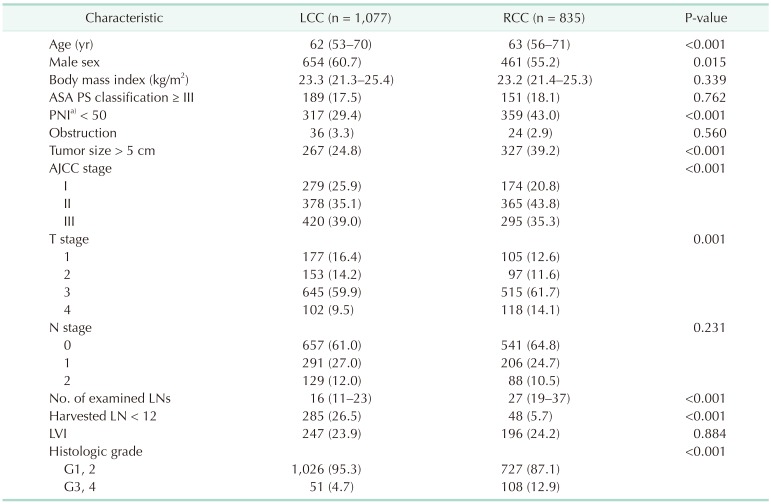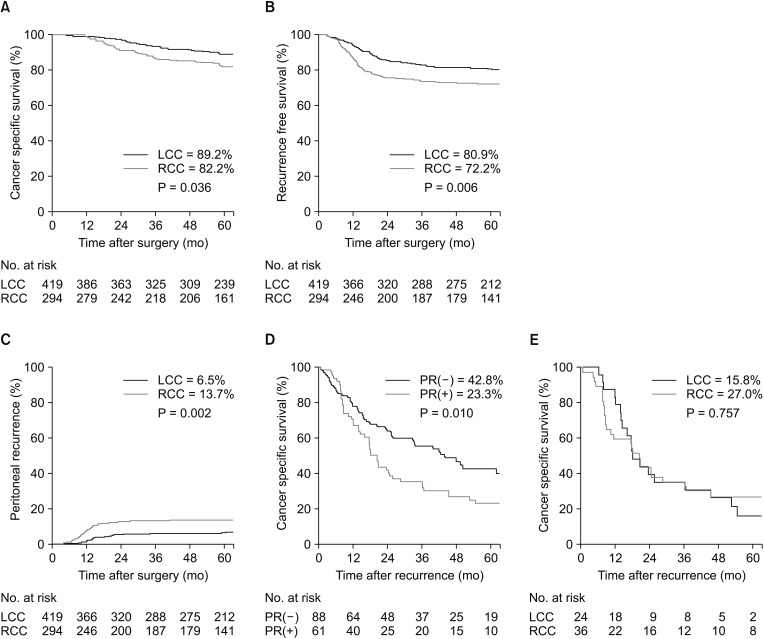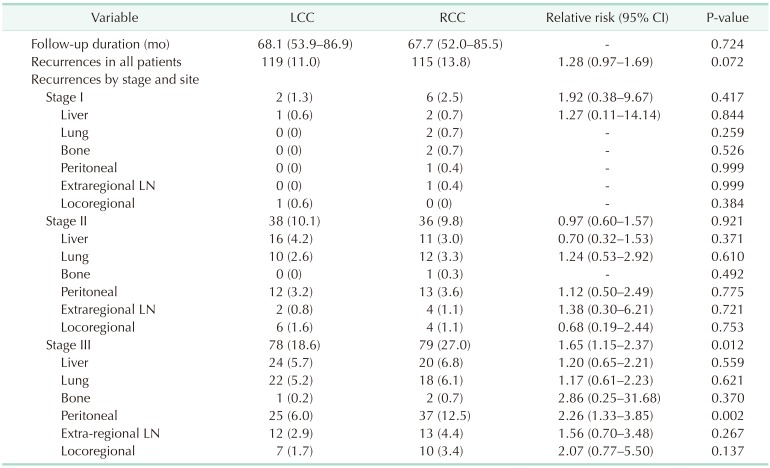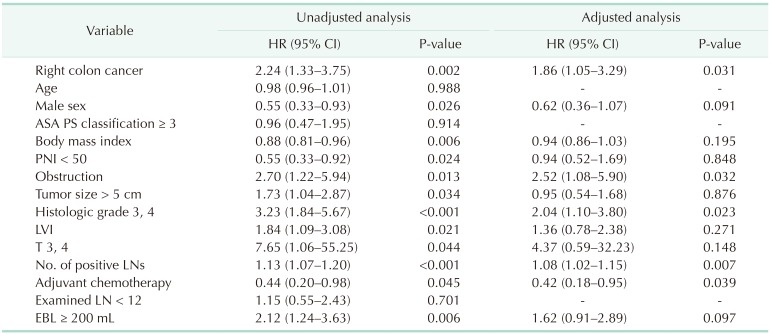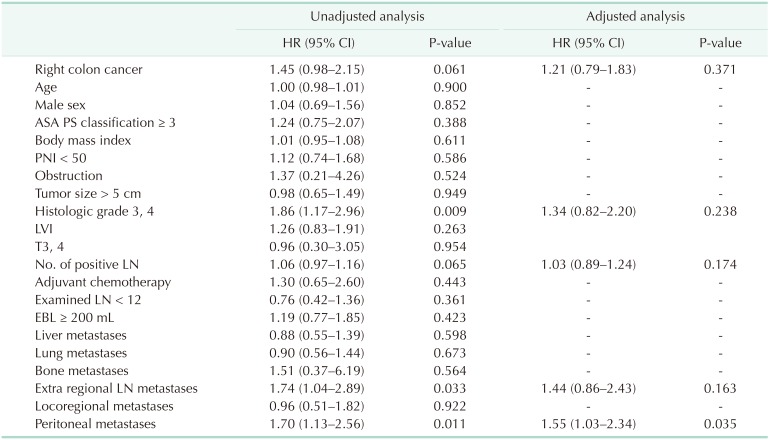Abstract
Purpose
Previous studies have reported conflicting results regarding the prognostic value of tumor sidedness in colon cancer. We investigated the oncologic impact of tumor location and examined whether recurrence patterns were related to tumor sidedness in colon cancer patients.
Methods
We identified stage I–III colon adenocarcinoma patients from a prospective colorectal cancer registry at Severance Hospital, Seoul, Korea, who underwent complete mesocolic excision between 2005 and 2012. Adjusted hazard ratios (HRs) and 95% confidence intervals (CI) for predictors of cancer-specific survival (CSS), recurrence-free survival (RFS), and cumulative recurrence at specific anatomic sites were examined using Cox proportional hazard regression analysis.
Results
Overall, 1,912 patients, 1,077 (56.3%) with left-sided colon cancer (LCC), and 835 (43.7%) with right-sided colon cancer (RCC), at a median follow-up of 59 months, were eligible and included in the study. In univariate analysis, similar 5-year CSS and RFS were observed for LCC and RCC in the total patient population, and when stratified by stage for stage I and II patients. For stage III patients, an adjusted Cox regression analysis indicated that RCC patients had a higher risk of cancer-specific mortality (HR, 1.75; 95% CI, 1.07–2.86; P = 0.024) and recurrence (HR, 1.78; 95% CI, 1.22–2.60; P = 0.003). Furthermore, RCC was an independent predictor of peritoneal recurrence (HR, 1.86; 95% CI, 1.05–3.29; P = 0.031) in stage III patients.
Conclusion
RCC correlated with worse CSS and RFS than LCC. In stage III patients, RCC correlated with increased risk of peritoneal recurrence. The reasons for these differences remain to be investigated.
Keywords: Colonic neoplasm; Right; Left; Neoplasm recurrence, local; Survival; Treatment outcome
INTRODUCTION
Evidence gathered over the past two decades indicates that colon cancer sidedness is an emerging prognostic factor. Right-sided colon cancer (RCC) shows distinct clinicopathological characteristics and long-term patient outcomes compared with left-sided colon cancer (LCC). Multiple studies have identified differential tumor biology as the reason for differences in patient prognoses for these 2 diseases [1,2,3,4,5]. RCC is more common in women and the elderly and these tumors are marked by a higher prevalence of poorly differentiated histology, microsatellite instability (MSI-H), and CpG island methylation than seen in LCC tumors. In addition, RCC is frequently associated with driver gene mutations in KRAS and BRAF [6,7,8].
Generally, RCC is associated with worse survival outcomes than LCC. However, reports regarding the prognostic role of primary tumor location with respect to colon cancer stage are conflicting [3,9]. For example, Warschkow et al. [3] showed that cancer-specific survival (CSS) was better in RCC patients than in LCC patients (adjusted hazard ratio [HR] for RCC, 0.90; 95% confidence interval [CI], 0.87–0.93; P < 0.001). In stage III patients, RCC and LCC had similar prognoses, whereas prognosis was better for stage I and II RCC patients than LCC patients after propensity score matching [3]. Further, neither the Warschkow study nor most prior studies addressed the question of whether cancer recurrence patterns are related to tumor laterality [10]. Therefore, in-depth investigations of survival and recurrence patterns between RCC and LCC are warranted. In this study, we examined both the prognostic role of tumor sidedness in stage I–III colon cancer and patterns of recurrence with respect to tumor location.
METHODS
The study protocol was approved by the Institutional Review Board of the Human Research Protection Center, Severance Hospital, Seoul, South Korea (approval number: 4-2018-0682). Informed consent was waived due to the retrospective analysis of this study.
Patients
Consecutive patients from a colorectal cancer registry who underwent surgical resection for colon cancer from November 2005 to October 2012 at Severance Hospital, Yonsei University College of Medicine, Seoul, South Korea were selected for this study. Analysis of the data was performed in March 2018. Patient samples were staged according to the American Joint Commission on cancer stage I, II, III colon adenocarcinoma, based on pathology. Tumor locations were assigned through the patients' medical records. Tumors proximal to the hepatic flexure were classified as RCC, and tumors located on the splenic flexure, descending and sigmoid colon were classified as LCC. The embryological reference point dividing RCC and LCC was the distal one third of the transverse colon. Because dividing the transverse colon into thirds can be ambiguous, transverse colon cancer was excluded from the study. Patients with tumors originating from the appendix (n = 35) and rectosigmoid junction (n = 247) or who received palliative resection (n = 174), resection for synchronous colon cancer (n = 80), or who had distant metastases (n = 441) were also excluded.
Surgical technique
As previously described, all patients underwent surgical resections based on the principle of complete mesocolic excision with central vascular ligation (CME with CVL) [11]. Briefly, en bloc resection included the tumor and its surrounding soft tissue enveloped by intact visceral fascia. Supplying vessels were ligated at their origin to achieve CVL. Specimens included pericolic, intermediate, and principal lymph nodes for adequate lymphadenectomy. If the tumor was suspected to have invaded or threatened the CME plane on the retroperitoneal side in the ascending or descending colon, we deepened our dissection to include perinephric fat tissues in the en bloc specimen.
Outcome measurements
Primary outcomes measured in this study were CSS, recurrence-free survival (RFS), and cumulative recurrence rate by specific anatomic site. CSS was defined as the length of time from the date of curative resection to the date of death from colon cancer. Patients who died of other causes were censored. RFS was defined as the length of time the patient survived without any evidence of colon cancer following primary tumor resection. Cumulative incidence of recurrence was defined as the probability that colon cancer recurrence had occurred before the given time. Patients who died without recurrence were censored.
Statistical analysis
Comparison of all variables between RCC and LCC was conducted using a chi-square test for categorical variables, and either Mann-Whitney's U test or independent t-test for continuous variables. The frequency of recurrence by site and stage was determined using rates and relative risk with a 95% confidence interval (CI). For long-term outcomes, Kaplan-Meier curves were drawn and log-rank tests were used to compare RCC and LCC. Multivariate Cox regression was performed to assess the effect of tumor location after adjusting for covariates. All tests were 2-sided, and P-values <0.05 were considered statistically significant. Statistical analysis was performed using SPSS software, version 20.0 (IBM Corp.).
RESULTS
Clinicopathological characteristics
Of the 1912 patients included in the study, 835 (43.7%) underwent right colectomy and 56.3% (n = 1,077) underwent left colectomies or sigmoid colectomy. RCC was more common in older patients and female patients. Other clinical features such as body mass index (BMI) and American Society of Anesthesiologists (ASA) physical status classification (III, IV) did not show significant differences between RCC and LCC. Prognostic nutritional index (PNI), an immunological and nutritional marker related to short- and long-term outcomes, was better in LCC patients [12,13].
Histological grade was higher, tumor size was larger, and invasion was deeper in RCC, whereas metastatic nodal status and the rate of lymphovascular invasion (LVI) were similar. RCC specimens contained more regional lymph nodes than did LCC specimens (Table 1).
Table 1. Clinicopathological characteristics of all included patients.
Values are presented as median (interquartile range) or number (%).
LCC, left-sided colon cancer; RCC, right-sided colon cancer; ASA PS, American Society of Anesthesiologists physical status; PNI, prognostic nutritional index; AJCC, American Joint Committee on Cancer; LN, lymph node; LVI, lymphovascular invasion.
a)PNI = 10 × serum albumin (g/dL) + 0.005 × total lymphocyte count (cells/mm3).
Surgical characteristics and perioperative outcomes
Minimally invasive surgery was used more frequently in LCC than RCC. Minimally invasive surgeries were more commonly converted to open surgeries with RCC, and RCC surgeries had longer operation times and more significant blood loss than LCC surgeries. Although the proportion of patients undergoing multivisceral resection was similar between groups, nine cases (1.1%) of RCC, but none of LCC, required duodenum resection to achieve complete R0 resection. The proportion of patients who underwent adjuvant chemotherapy was comparable between the 2 groups (Table 2).
Table 2. Surgical characteristics and perioperative outcomes.
Values are presented as number (%) or median (interquartile range).
LCC, left-sided colon cancer; RCC, right-sided colon cancer; MIS, minimally invasive surgery; EBL, estimated blood loss.
Survival and recurrence
Differences in 5-year CSS between RCC and LCC for all stages combined (91.9% vs. 94.7%, P = 0.110), and for stage I (100% vs. 99.6%, P = 0.273), and stage II (95.8% vs. 97.1%, P = 0.739) cancers were not observed in unadjusted survival analyses. Further, unadjusted survival curves demonstrated no significant differences in the 5-year RFS between RCC and LCC for all stages combined (85.6% vs. 88.0%, P = 0.079), and for stage I (98.3% vs. 97.0%, P = 0.325), and stage II (88.9% vs. 90.2%, P = 0.681) cancers. However, for stage III patients, unadjusted Cox regression showed an increased risk for both cancer-specific mortality (HR, 1.53; 95% CI, 1.02–2.30; P = 0.037) and recurrence (HR, 1.56; 95% CI, 1.13–2.14; P = 0.006) for RCC compared with LCC (Fig. 1A, B). Subsequent multivariable analysis for CSS and RFS were performed with possible confounders including age, sex, BMI, ASA physical status classification, PNI, obstruction, tumor size, histologic grade, LVI, adjuvant chemotherapy, number of examined lymph nodes, estimated blood loss (EBL), T stage, and number of positive LN in stage III. After adjustment, RCC patients had a higher risk of cancer-specific mortality (HR, 1.75; 95% CI, 1.07–2.86; P = 0.024) and recurrence (HR, 1.78; 95% CI, 1.22–2.60; P = 0.003) (Table 3).
Fig. 1. Kaplan-Meier curves for survival analysis within stage III colon cancer patients. Cancer specific survival (CSS) (A), recurrence-free survival (RFS) (B), peritoneal recurrence (PR) (C), CSS from recurrence to death (CSS2) according to presence of peritoneal recurrence (D), and CSS2 in patients with peritoneal recurrence (E). LCC, left-sided colon cancer; RCC, right-sided colon cancer.
Table 3. Multivariate analysis for cancer specific- and recurrence free survival in patients stratified by stage.
Covariates: age, sex, BMI, ASA PS classification, PNI, obstruction, tumor size, AJCC stages, histologic grade, LVI, adjuvant chemotherapy, No. of examined lymph nodes, EBL.
HR, hazard ratio; CI, confidence interval; CSS, cancer specific survival; RFS, recurrence free survival; BMI, body mass index; ASA PS, American Society of Anethesiologists physical status; PNI, prognostic nutritional index; AJCC, American Joint Committee on Cancer; LVI, lymphovacular invasion; EBL, estimated blood loss.
a)Comparing right colon cancer with left colon cancer. b)95% confidence interval of stage I was very wide due to only one event was noted during follow-up.
When all recurrences were stratified by stage and site, the recurrence rate for all sites was higher only in stage III RCC (27.0% vs. 18.6%, P = 0.012), and peritoneal recurrence (PR) was approximately twice as frequent in RCC (12.5%) than LCC (6%) (Table 4). Five-year cumulative incidence of PR showed significant difference between RCC and LCC in stage III colon cancer (13.7% vs. 6.5%; P = 0.002) (Fig. 1C). A subsequent Cox proportional hazard regression for PR was conducted including all clinical and pathological variables. The locational impact of the tumor on PR in stage III patients persisted following adjusted analysis (Table 5).
Table 4. Details of recurrence during follow-up.
Values are presented as median (interquartile range) or number (%).
LCC, left-sided colon cancer; RCC, right-sided colon cancer; CI, confidence interval; LN, lymph node.
Table 5. Multivariable analysisa) for peritoneal recurrence in stage III colon cancer patients.
HR, hazard ratio; CI, confidence interval; ASA PS, American Society of Anethesiologists physical status; PNI, prognostic nutritional index; LVI, lymphovascular invasion; LN, lymph node; EBL, estimated blood loss.
a)After all variables that showed P ≥ 0.2 in univariate analysis were removed, multivariable Cox regression analysis was performed using the enter method.
CSS after recurrence (CSS2), was defined as the period between the date that recurrence was initially recognized and the date of either death from colon cancer or the last follow-up. The Kaplan-Meier curve and log rank test for stage III colon cancer revealed that patients with PR had significantly worse CSS2 than those without PR (Fig. 1D). Further comparison of CSS2 between RCC and LCC showed no differences in stage III patients with PR (Fig. 1E). In multivariable Cox regression analysis of stage III patients, peritoneal metastases exhibited worse results for CSS2 (HR, 1.55; 95% CI, 1.03–2.34; P = 0.035), after adjusting metastases from other sites (Table 6).
Table 6. Multivariable analysisa) for cancer specific survival after recurrence in stage III patients.
HR, hazard ratio; CI, confidence interval; ASA PS, American Society of Anethesiologists physical status; PNI, prognostic nutritional index; LVI, lymphovascular invasion; LN, lymph node; EBL, estimated blood loss.
a)After all variables that showed P ≥ 0.2 in univariate analysis were removed, multivariable Cox regression analysis was performed using the enter method.
DISCUSSION
Consistent with prior studies, we found that stage III RCC patients had worse prognoses than stage III LCC patients. However, we did not detect significant differences in CSS or RFS between RCC and LCC in either our total patient population or in patients with stage I or stage II disease. Other studies have reported conflicting findings at different cancer stages, although the majority showed worse prognosis for stage III RCC patients [1,2]. The most likely explanation for not uncovering differences in the survival of stage I and II patients in this study is a lack of statistical power due to our relatively small sample size. Other studies, for example those that rely on the SEER (Surveillance, Epidemiology, and End Results Program), have data for tens of thousands of patients. Another possible reason for recovering differences only in stage III patients is that the radical lymphadenectomies performed in this study effectively removed remnant tumor cells from stage I and II patients, but not from stage III RCC patients, resulting in worse oncologic outcomes for this group. In this context, the extensive lymphadenectomies performed in this study may have minimized the influence of tumor sidedness on stage I and II patient outcomes, precluding sidedness as a useful prognostic factor for these patients. The median number of regional lymph nodes removed during surgery in this study was 27 for RCC and 16 for LCC, comparable with prospective studies in which surgeons performed CME [14]. In line with more complete resections impacting outcome, Ishihara et al. [15] showed that tumor location was not a significant predictor of CSS in patients with R0 resection (both primary and metastatic tumors), whereas RCC was associated with worse prognosis in patients with palliative resection. They speculated that “radicality of surgery may mitigate the difference in biological aggressiveness between RCC and LCC” [15]. This indicates that surgical completeness or quality may be particularly important for advanced RCC.
Another key finding of this study is that RCC significantly raises the risk of PR in stage III patients (HR, 1.86; 95% CI, 1.05–3.29; P = 0.031). Peritoneal metastasis is generally thought to result from direct implantation of cancer cells via serosal invasion, extravasation of cancer cells from perforated or obstructed bowel, and leakage of tumor cells from severed lymphatics or veins [16]. Our data showed the risk of PR was higher in stage III RCC after adjusting for known risk factors such as age, T stage, number of metastatic nodes, obstruction, and adjuvant chemotherapy [17].
The cause for frequent occurrence of peritoneal metastasis in RCC is not clear, but it is thought to be related to tumor biology. Mutations in BRAF and microsatellite instability (MSI) are more common in RCC than LCC [18,19]. Tran et al. [20] compared colon tumors with and without BRAF mutations and found higher rates of peritoneal metastases (46% vs. 24%, P = 0.001), and poorer overall survival (10.4 months vs. 34.7 months, P < 0.001) in patients with mutant tumors. Further, tumors with BRAF mutations frequently display adverse histological features such as lymphatic invasion, perineural invasion, high tumor budding, and mucinous and signet-ring cell histology [19].
Mismatch repair (MMR) genes are also frequently mutated in colon cancer. MMR deficiency can be assessed by examining MSI as a proxy for compromised MMR. However, few studies have examined cancer recurrence patterns with respect to MMR deficiency. Kim et al. [21] reported peritoneal metastases were more common in MSI-high tumors, compared with MSI-low/microsatellite stable tumors, in stages I–III colorectal cancer (40.0% vs. 12.3%, P = 0.003). They also demonstrated that MSI-high status was a predictor of worse overall survival in patients with recurrence (HR, 1.36; P = 0.035). Because BRAF mutation status was not available for this study, we examined MMR status with respect to tumor location. We noted that MSI-high status was significantly more common in RCC than LCC (12.4% vs. 6.3%; P = 0.021) (Supplementary Table 1), supporting the idea that tumor biology might underlie the frequent PRs seen in stage III RCC patients.
Peritoneal metastasis is a powerful negative prognostic factor in colorectal cancer. The prognosis for patients with isolated peritoneal metastases is equally as poor for patients with multiple-organ metastases [22,23]. In this study, patients with PR had a worse prognosis with respect to CSS2 than those with other types of recurrences, and PR was a predictor of CSS2 after adjusting for other site recurrences in stage III patients. Survival after PR was similar for both RCC and LCC patients. We also found no difference in the rate of curative resection as a treatment for recurrence in LCC and RCC patients (50.0% for LCC and 40.3% for RCC; P = 0.383) (Supplementary Table 2). The presence of PR seems to be a major contributor to the differences in survival of patients with stage III RCC and LCC.
Mutations in KRAS that confer tumors resistant to anti-epidermal growth factor receptor (EGFR) antibody-based therapies are likely to contribute to the lower survival rates of RCC patients. Patients with KRAS mutations are precluded from anti-EGFR antibody-based treatments for metastatic colorectal cancer (mCRC). However, even in the absence of KRAS mutations, RCC patients may have worse outcomes. A recent meta-analysis of 6 randomized trials compared chemotherapy coupled with anti-EGFR antibody treatment (experimental arm) to chemotherapy alone and to chemotherapy coupled with bevacizumab (an anti-vascular endothelial growth factor (VEGF) antibody) treatment (control arms) in mCRC patients with wild-type RAS. Overall survival and progression-free survival were improved in LCC patients, but not RCC patients, treated with anti-EGFR antibody [24]. This suggests that tumor location may be a predictor of anti-EGFR antibody therapy efficacy.
This study has several limitations. First, despite efforts to collect complete and accurate data, a retrospective review of patients from a single institution may diminish the reliability and generality of the results. For instance, primary tumor location may be reported differently by different surgeons, especially in cases of rectosigmoid junction tumors. However, a strength of this study is that treatment variability was likely minimized as treatments were performed at a single institution over a relatively short time period (7 years). Second, molecular profiling data for tumors was limited. BRAF and KRAS status was not available, which prevented testing the hypothesis that BRAF and KRAS mutations result in a worse prognosis for stage III RCC patients.
Despite our current understanding of how molecular profiles vary according to tumor location, the chief molecules and pathways that lead to better and worse outcomes for LCC and RCC, respectively, are still unknown. Thus, studies of LCC and RCC patient populations bearing defined tumor genotypes will be required to reveal the how tumor location predicts patient survival.
In conclusion, right-sided colon tumors have worse CSS and RFS, mainly due to the higher risk of PR in stage III colon cancer patients. This suggests that primary tumor location might serve as a biomarker for predicting peritoneal recurrence. The reason for this observation may be due to differences in LCC and RCC tumor biology that remain to be uncovered.
ACKNOWLEDGEMENTS
Financial support for English proofreading was provided by Yonsei University College of Medicine.
Footnotes
CONFLICTS OF INTEREST: No potential conflict of interest relevant to this article was reported.
SUPPLEMENTARY MATERIALS
Supplementary Tables 1–2 can be found via https://www.astr.or.kr/src/sm/astr-96-296-s001.pdf.
Microsatellite instability status in stage I, II, and III patients
Treatment for colon cancer recurrence in stage III patients
References
- 1.Meguid RA, Slidell MB, Wolfgang CL, Chang DC, Ahuja N. Is there a difference in survival between right-versus left-sided colon cancers? Ann Surg Oncol. 2008;15:2388–2394. doi: 10.1245/s10434-008-0015-y. [DOI] [PMC free article] [PubMed] [Google Scholar]
- 2.Weiss JM, Pfau PR, O'Connor ES, King J, LoConte N, Kennedy G, et al. Mortality by stage for right-versus left-sided colon cancer: analysis of surveillance, epidemiology, and end results--Medicare data. J Clin Oncol. 2011;29:4401–4409. doi: 10.1200/JCO.2011.36.4414. [DOI] [PMC free article] [PubMed] [Google Scholar]
- 3.Warschkow R, Sulz MC, Marti L, Tarantino I, Schmied BM, Cerny T, et al. Better survival in right-sided versus left-sided stage I - III colon cancer patients. BMC Cancer. 2016;16:554. doi: 10.1186/s12885-016-2412-0. [DOI] [PMC free article] [PubMed] [Google Scholar]
- 4.Benedix F, Kube R, Meyer F, Schmidt U, Gastinger I, Lippert H, et al. Comparison of 17,641 patients with right- and left-sided colon cancer: differences in epidemiology, perioperative course, histology, and survival. Dis Colon Rectum. 2010;53:57–64. doi: 10.1007/DCR.0b013e3181c703a4. [DOI] [PubMed] [Google Scholar]
- 5.Lim DR, Kuk JK, Kim T, Shin EJ. Comparison of oncological outcomes of right-sided colon cancer versus left-sided colon cancer after curative resection: Which side is better outcome? Medicine (Baltimore) 2017;96:e8241. doi: 10.1097/MD.0000000000008241. [DOI] [PMC free article] [PubMed] [Google Scholar]
- 6.Missiaglia E, Jacobs B, D'Ario G, Di Narzo AF, Soneson C, Budinska E, et al. Distal and proximal colon cancers differ in terms of molecular, pathological, and clinical features. Ann Oncol. 2014;25:1995–2001. doi: 10.1093/annonc/mdu275. [DOI] [PubMed] [Google Scholar]
- 7.Nawa T, Kato J, Kawamoto H, Okada H, Yamamoto H, Kohno H, et al. Differences between right- and left-sided colon cancer in patient characteristics, cancer morphology and histology. J Gastroenterol Hepatol. 2008;23:418–423. doi: 10.1111/j.1440-1746.2007.04923.x. [DOI] [PubMed] [Google Scholar]
- 8.Yang SY, Cho MS, Kim NK. Difference between right-sided and left-sided colorectal cancers: from embryology to molecular subtype. Expert Rev Anticancer Ther. 2018;18:351–358. doi: 10.1080/14737140.2018.1442217. [DOI] [PubMed] [Google Scholar]
- 9.Moritani K, Hasegawa H, Okabayashi K, Ishii Y, Endo T, Kitagawa Y. Difference in the recurrence rate between right- and left-sided colon cancer: a 17-year experience at a single institution. Surg Today. 2014;44:1685–1691. doi: 10.1007/s00595-013-0748-5. [DOI] [PMC free article] [PubMed] [Google Scholar]
- 10.Ishihara S, Murono K, Sasaki K, Yasuda K, Otani K, Nishikawa T, et al. Impact of primary tumor location on postoperative recurrence and subsequent prognosis in nonmetastatic colon cancers: a multicenter retrospective study using a propensity score analysis. Ann Surg. 2018;267:917–921. doi: 10.1097/SLA.0000000000002206. [DOI] [PubMed] [Google Scholar]
- 11.Cho MS, Baek SJ, Hur H, Soh Min B, Baik SH, Kyu Kim N. Modified complete mesocolic excision with central vascular ligation for the treatment of right-sided colon cancer: long-term outcomes and prognostic factors. Ann Surg. 2015;261:708–715. doi: 10.1097/SLA.0000000000000831. [DOI] [PubMed] [Google Scholar]
- 12.Noh GT, Han J, Cho MS, Hur H, Min BS, Lee KY, et al. Impact of the prognostic nutritional index on the recovery and long-term oncologic outcome of patients with colorectal cancer. J Cancer Res Clin Oncol. 2017;143:1235–1242. doi: 10.1007/s00432-017-2366-x. [DOI] [PubMed] [Google Scholar]
- 13.Tokunaga R, Sakamoto Y, Nakagawa S, Miyamoto Y, Yoshida N, Oki E, et al. Prognostic nutritional index predicts severe complications, recurrence, and poor prognosis in patients with colorectal cancer undergoing primary tumor resection. Dis Colon Rectum. 2015;58:1048–1057. doi: 10.1097/DCR.0000000000000458. [DOI] [PubMed] [Google Scholar]
- 14.Kontovounisios C, Kinross J, Tan E, Brown G, Rasheed S, Tekkis P. Complete mesocolic excision in colorectal cancer: a systematic review. Colorectal Dis. 2015;17:7–16. doi: 10.1111/codi.12793. [DOI] [PubMed] [Google Scholar]
- 15.Ishihara S, Nishikawa T, Tanaka T, Tanaka J, Kiyomatsu T, Kawai K, et al. Prognostic impact of tumor location in stage IV colon cancer: a propensity score analysis in a multicenter study. Int J Surg. 2014;12:925–930. doi: 10.1016/j.ijsu.2014.07.270. [DOI] [PubMed] [Google Scholar]
- 16.Dawson LE, Russell AH, Tong D, Wisbeck WM. Adenocarcinoma of the sigmoid colon: sites of initial dissemination and clinical patterns of recurrence following surgery alone. J Surg Oncol. 1983;22:95–99. doi: 10.1002/jso.2930220208. [DOI] [PubMed] [Google Scholar]
- 17.Segelman J, Granath F, Holm T, Machado M, Mahteme H, Martling A. Incidence, prevalence and risk factors for peritoneal carcinomatosis from colorectal cancer. Br J Surg. 2012;99:699–705. doi: 10.1002/bjs.8679. [DOI] [PubMed] [Google Scholar]
- 18.Nitsche U, Stogbauer F, Späth C, Haller B, Wilhelm D, Friess H, et al. Right sided colon cancer as a distinct histopathological subtype with reduced prognosis. Dig Surg. 2016;33:157–163. doi: 10.1159/000443644. [DOI] [PubMed] [Google Scholar]
- 19.Sinicrope FA, Mahoney MR, Yoon HH, Smyrk TC, Thibodeau SN, Goldberg RM, et al. Analysis of molecular markers by anatomic tumor site in stage III Colon Carcinomas from Adjuvant Chemotherapy Trial NCCTG N0147 (Alliance) Clin Cancer Res. 2015;21:5294–5304. doi: 10.1158/1078-0432.CCR-15-0527. [DOI] [PMC free article] [PubMed] [Google Scholar]
- 20.Tran B, Kopetz S, Tie J, Gibbs P, Jiang ZQ, Lieu CH, et al. Impact of BRAF mutation and microsatellite instability on the pattern of metastatic spread and prognosis in metastatic colorectal cancer. Cancer. 2011;117:4623–4632. doi: 10.1002/cncr.26086. [DOI] [PMC free article] [PubMed] [Google Scholar]
- 21.Kim CG, Ahn JB, Jung M, Beom SH, Kim C, Kim JH, et al. Effects of microsatellite instability on recurrence patterns and outcomes in colorectal cancers. Br J Cancer. 2016;115:25–33. doi: 10.1038/bjc.2016.161. [DOI] [PMC free article] [PubMed] [Google Scholar]
- 22.Arakawa K, Kawai K, Ishihara S, Hata K, Nozawa H, Oba K, et al. Prognostic significance of peritoneal metastasis in stage IV colorectal cancer patients with R0 resection: a multicenter, retrospective study. Dis Colon Rectum. 2017;60:1041–1049. doi: 10.1097/DCR.0000000000000858. [DOI] [PubMed] [Google Scholar]
- 23.Franko J, Shi Q, Meyers JP, Maughan TS, Adams RA, Seymour MT, et al. Prognosis of patients with peritoneal metastatic colorectal cancer given systemic therapy: an analysis of individual patient data from prospective randomised trials from the Analysis and Research in Cancers of the Digestive System (ARCAD) database. Lancet Oncol. 2016;17:1709–1719. doi: 10.1016/S1470-2045(16)30500-9. [DOI] [PubMed] [Google Scholar]
- 24.Arnold D, Lueza B, Douillard JY, Peeters M, Lenz HJ, Venook A, et al. Prognostic and predictive value of primary tumour side in patients with RAS wild-type metastatic colorectal cancer treated with chemotherapy and EGFR directed antibodies in six randomized trials. Ann Oncol. 2017;28:1713–1729. doi: 10.1093/annonc/mdx175. [DOI] [PMC free article] [PubMed] [Google Scholar]
Associated Data
This section collects any data citations, data availability statements, or supplementary materials included in this article.
Supplementary Materials
Microsatellite instability status in stage I, II, and III patients
Treatment for colon cancer recurrence in stage III patients



